| کد مقاله | کد نشریه | سال انتشار | مقاله انگلیسی | نسخه تمام متن |
|---|---|---|---|---|
| 6300039 | 1617917 | 2015 | 8 صفحه PDF | دانلود رایگان |
- Relative abundance of reptiles in fragmented agricultural landscapes increases with remnant forest extent.
- Small-bodied and less-vagile reptiles increased with extent of old regrowth.
- Fragmentation did not affect landscape-level richness or abundance.
- Remnant and old (>30Â years age) regrowth forest extent drive landscape-level reptile responses.
- Allowing cleared forests to regenerate may be a cost-effective restoration strategy.
The conversion of forested landscapes to agriculture commonly results in three main changes to landscape structure: forest loss, fragmentation, and the creation of novel habitats such as forest regrowth. Here we apply a landscape-level survey design to test how reptiles respond to patterns resulting from these three processes in the Brigalow Belt of eastern Australia, a region highly modified by recent agricultural expansion. We surveyed reptiles in 24 agricultural landscapes (each 2.5Â ÃÂ 2.5Â km) that contained mosaics of remnant and regrowth vegetation of various ages and extents. We found that none of the landscape attributes significantly influenced landscape-level species richness of reptiles. On the other hand, the total abundance of reptiles per unit of sampling effort increased with remnant forest extent. In addition, abundance of small-bodied and less-vagile reptiles was positively affected by the extent of old regrowth. Fragmentation did not have important effects on the landscape-level species richness and total abundance of reptiles. Our finding that forest extent is the primary landscape attribute that influences reptiles suggests that, despite expectations to the contrary, the taxon responds in a manner similar to more vagile taxa, such as birds. However, the fact that total abundance but not species richness was the measure that responded suggests different mechanisms are in play. Allowing regrowth forests to regenerate beyond 30Â years of age may be a cost-effective strategy for landscape-level conservation of reptiles in this region.
Journal: Biological Conservation - Volume 184, April 2015, Pages 174-181
